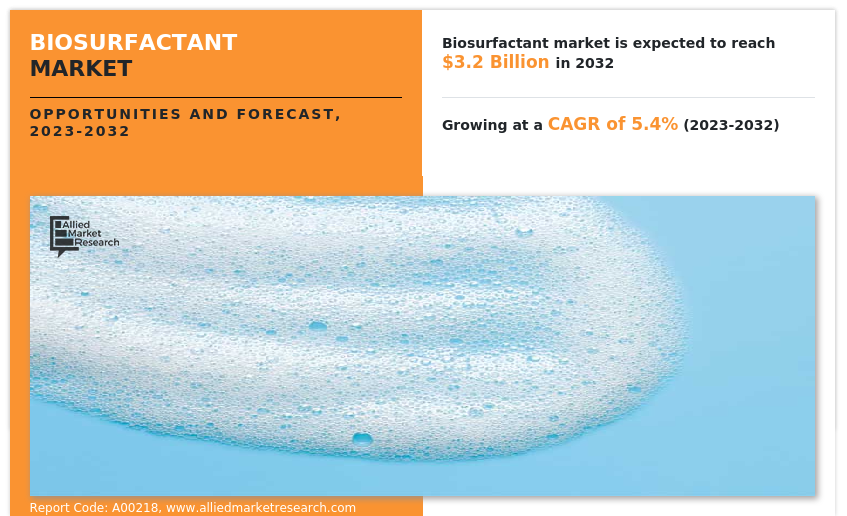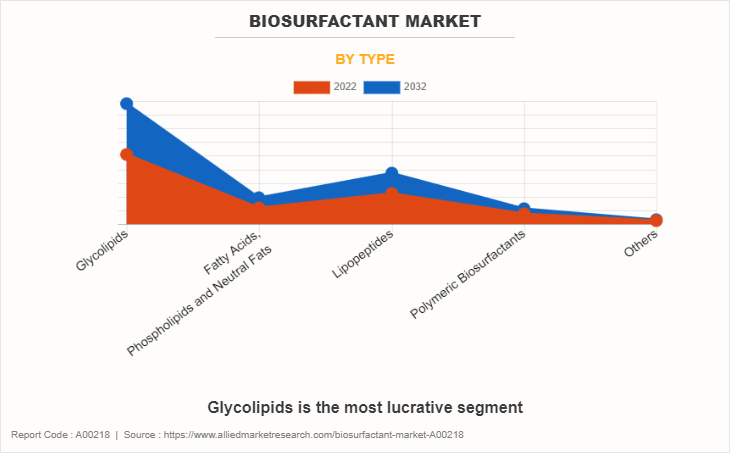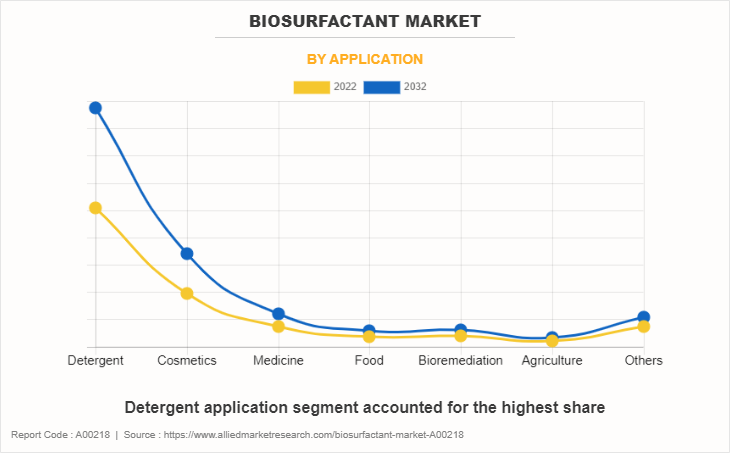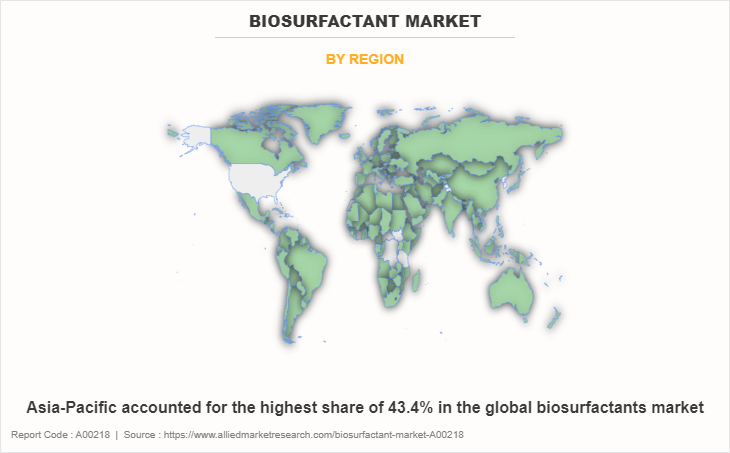Biosurfactant Market Research, 2032
The global biosurfactant market was valued at $1.9 billion in 2022, and is projected to reach $3.2 billion by 2032, growing at a CAGR of 5.4% from 2023 to 2032.
Report Key Highlighters:
- The report provides competitive dynamics by evaluating business segments, product portfolios, target market revenue, geographical presence, and key strategic developments by prominent manufacturers.
- The global biosurfactants market is fragmented in nature among prominent companies such as Evonik, Biotensidon GmbH, Saraya.Co.Ltd, Allied Carbon Solution, BASF SE, Lankem Ltd., Holiferm, Solvay, Unilever PLC, and Jeneil Biotech.
- The study contains qualitative information such as the market dynamics (drivers, restraints, challenges, and opportunities), key regulation analysis, pricing analysis, and Porter‐™s Five Forces Analysis across North America, Europe, Asia-Pacific, and LAMEA regions.
- Latest trends in global biosurfactants market such as undergoing R&D activities, regulatory guidelines, and government initiatives are analyzed across 16 countries in 4 different regions.
- More than 3,200 biosurfactants-related product literatures, industry releases, annual reports, and other such documents of key industry participants along with authentic industry journals and government websites have been reviewed for generating high-value industry insights for global biosurfactants market.

Biosurfactants are surface-active molecules produced by living organisms, particularly microorganisms such as bacteria, yeast, and fungi. These molecules possess both hydrophilic (water-attracting) and hydrophobic (water-repelling) regions, allowing them to interact with both water and oil or other non-polar substances. This unique structure gives biosurfactants the ability to reduce surface tension and promote the dispersion of hydrophobic compounds in aqueous environments.
Both developed and developing economies are imposing regulations and acts to reduce and mitigate the environmental impacts caused by synthetic surfactants. Biosurfactants are often produced from renewable resources such as plant oils, microbial fermentation, and other bio-based feedstocks. Thus, the emphasis on sustainability and the use of renewable resources has been a significant driver for the global biosurfactants market
Moreover, bio.surfactants are generally more biodegradable compared to their synthetic counterparts. This quality is attractive to industries looking to reduce their environmental impact and meet regulatory requirements.
Furthermore, growing awareness among consumers about the environmental and health impacts of synthetic surfactants has led to an increased preference for natural and sustainable alternatives, driving the demand for biosurfactants.
Additionally, biosurfactants find applications in diverse industries, including food and beverages, pharmaceuticals, agriculture, cosmetics, and oil recovery. The versatility of biosurfactants and their ability to replace traditional surfactants in various applications contribute to the growth of the global biosurfactants market.
According to a report published by Research Centre for Energy Resources and Consumption (CIRCE) in 2023, out of 100 around 50% consumers are aware of the advantages of biosurfactants, while 12% of them utilize biosurfactants. This number is projected to grow owing to factors such as increase in environmental awareness and cost effectiveness of biosurfactants; thus, fueling the growth of the biosurfactants market during the forecast period.
However, the production of biosurfactants is more expensive as compared to synthetic surfactants which in turn has limited the widespread adoption of biosurfactants across end-users. Moreover, the biosurfactants manufacturing industry faces competition with synthetic surfactants manufacturing industry. The well-established presence of synthetic surfactants may make it challenging for biosurfactants to gain widespread acceptance, despite eco-friendly properties of biosurfactants. These factors altogether may restrain the growth of the global biosurfactants market during the forecast period.
On the contrary, ongoing research and development efforts contribute to the discovery of novel biosurfactants with enhanced properties. This represents an opportunity for innovation and differentiation within the market. The development of biosurfactants with improved functionalities, cost-effectiveness, and tailored characteristics can open-up new avenues and applications, driving market expansion and competitiveness.
The global biosurfactants market is segmented on the basis of type, application, and region. On the basis of type, the market is categorized into glycolipids, fatty acids, phospholipids and neutral fats, lipopeptides, polymeric biosurfactants, and others. As per application, it is divided into detergents, cosmetics, medicine, food, bioremediation, agriculture, and others. Region-wise, the market is studied across North America, Europe, Asia-Pacific, and LAMEA.
Key business developments to flourish the market:
January 8th, 2024 Holiferm, a UK based biosurfactants manufacturing company secures an investment of around $23.3 million for manufacturing sustainable biosurfactants. This capital will help Holiferm to scale up its commercial plant. Currently Holiferm‐™s Wallasey plant has a current capacity of 1.1 KTA. With this new investment, new fermenters will be installed in the plant, increasing capacity to 3.5 KTA around the end of 2024, then further scaling up to 1 5KTA capacity. This strategic business development may enhance the availability of biosurfactants.

In 2022, the glycolipids segment was the largest revenue generator, and is anticipated to grow at a CAGR of 5.7% during the forecast period. Glycolipids play a crucial role in various biological processes, including cell recognition, signaling, and immune response. Researchers and pharmaceutical companies may be increasingly interested in studying and developing glycolipids for therapeutic purposes, leading to an increased demand.

By application, the detergent segment dominated the global market in 2022, and is anticipated to grow at a CAGR of 5.6% during the forecast period. One of the primary advantages of biosurfactants is their biodegradability. Unlike some synthetic surfactants, biosurfactants are typically derived from renewable resources and can be broken down by natural processes. This characteristic is appealing in the context of environmentally friendly and sustainable detergent formulations.

The Asia-Pacific biosurfactants market size is projected to grow at the highest CAGR of 5.8% during the forecast period and accounted for morethan 40% of biosurfactants market share in 2022. The Asia-Pacific region has shown an increasing interest in sustainable and environmentally friendly products across various industries, including the detergent and cleaning sector. Furthermore, consumer awareness regarding the environmental impact of household products has been on the rise. This has led to a demand for greener and safer alternatives in cleaning and personal care products. Biosurfactants, being derived from renewable resources and often produced through environmentally friendly processes, may gain traction in response to consumer preferences.
The global biosurfactants market profiles leading players that include Evonik, Biotensidon GmbH, Saraya. Co. Ltd, Allied Carbon Solution, BASF SE, Lankem Ltd., Holiferm, Solvay, Unilever PLC, and Jeneil Biotech.
Other key manufacturers that are actively engaged in the production of biosurfactants include AmphiStar Biosurfactants, AG Chemi Group, H. Ziolkowsky GmbH, Logos LLC, Dispersa, TeeGee Biotech, and others. The global biosurfactants market report provides in-depth competitive analysis as well as profiles of these major players.
Key Benefits For Stakeholders
- This report provides a quantitative analysis of the market segments, current trends, estimations, and dynamics of the biosurfactant market analysis from 2022 to 2032 to identify the prevailing biosurfactant market opportunities.
- The market research is offered along with information related to key drivers, restraints, and opportunities.
- Porter's five forces analysis highlights the potency of buyers and suppliers to enable stakeholders make profit-oriented business decisions and strengthen their supplier-buyer network.
- In-depth analysis of the biosurfactant market segmentation assists to determine the prevailing market opportunities.
- Major countries in each region are mapped according to their revenue contribution to the global market.
- Market player positioning facilitates benchmarking and provides a clear understanding of the present position of the market players.
- The report includes the analysis of the regional as well as global biosurfactant market trends, key players, market segments, application areas, and market growth strategies.
IMPACT OF COVID-19 ON THE GLOBAL BIOSURFACTANTS MARKET
- The biosurfactants market, like many other industries, have experienced disruptions in the supply chain. Lockdowns, restrictions on movement, and other measures taken to control the spread of the virus affected the production and transportation of raw materials, impacting the overall supply chain.
- The demand for various products, including biosurfactants, have been influenced by changes in consumer behavior during the pandemic. For instance, increased awareness of hygiene and sustainability might have led to a surge in demand for bio-based and eco-friendly products, potentially benefiting the biosurfactants market.
- However, the global biosurfactants market have benefited from an increased focus on sustainability and environmental concerns post-COVID. Consumers and industries have become more inclined towards bio-based and eco-friendly products, which in turn has boosted the demand for biosurfactants.
Biosurfactant Market Report Highlights
| Aspects | Details |
| Market Size By 2032 | USD 3.2 billion |
| Growth Rate | CAGR of 5.4% |
| Forecast period | 2022 - 2032 |
| Report Pages | 403 |
| By Type |
|
| By Application |
|
| By Region |
|
| Key Market Players | Jeneil Biotech, Inc., Biotensidon GmbH, Solvay, Holiferm, Saraya.Co.Ltd, BASF SE, Unilever PLC, Allied Carbon Solution, Evonik |
Analyst Review
According to the CXOs of leading ompanies, the the biosurfactants market is propelled by a confluence of factors that underscore the need for sustainable and environmentally friendly solutions across diverse industries. As regulatory pressures increase, and consumer awareness grows, the demand for biosurfactants is likely to continue its upward trajectory. Moreover, the versatility of biosurfactants, spanning applications from oil recovery to agriculture and bioremediation, positions them as a key player in the global shift towards a more sustainable and eco-conscious future.
Growing awareness for environmental sustainability, stringent regulatory pressures for the use of synthetic detergents, increasing oil & gas applications, and rise in demand from agricultural sector are the upcoming trends of Biosurfactant Market in the world.
Detergent is the leading application of Biosurfactant Market.
Asia-Pacific is the largest regional market for biosurfactant.
The global biosurfactants market was valued for $1.9 billion in 2022 and is estimated to reach $3.2 billion by 2032, exhibiting a CAGR of 5.4% from 2023 to 2032
Evonik, Biotensidon GmbH, Saraya.Co.Ltd, Allied Carbon Solution, BASF SE, Lankem Ltd., Holiferm, Solvay, Unilever PLC, and Jeneil Biotech are the top companies to hold the market share in the global bisoufactants market.
Loading Table Of Content...
Loading Research Methodology...


